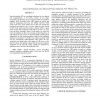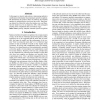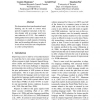128
Voted
CVPR
2012
IEEE
13 years 3 months ago
2012
IEEE
In this work a Gaussian Hidden Markov Model (GHMM) based automatic sign language recognition system is built on the SIGNUM database. The system is trained on appearance-based feat...
121
Voted
IUI
2012
ACM
13 years 8 months ago
2012
ACM
The next big step in embedded, mobile speech recognition will be to allow completely free input as it is needed for messaging like SMS or email. However, unconstrained dictation r...
143
Voted
ICASSP
2011
IEEE
14 years 4 months ago
2011
IEEE
We propose a new transform speech codec that jointly encodes a wideband waveform and its corresponding wideband and narrowband speech recognition features. For distributed speech ...
128
Voted
ICASSP
2011
IEEE
14 years 4 months ago
2011
IEEE
Speech translation (ST) is an enabling technology for cross-lingual oral communication. A ST system consists of two major components: an automatic speech recognizer (ASR) and a ma...
104
Voted
ICASSP
2011
IEEE
14 years 4 months ago
2011
IEEE
Recognizer Output Voting Error Reduction (ROVER), is a well-known procedure for decoders’ combination aiming at reducing the Word Error Rate (WER) in transcription applications....
126
Voted
ICASSP
2011
IEEE
14 years 4 months ago
2011
IEEE
Polish is a synthetic language with a high morpheme-perword ratio. It makes use of a high degree of inflection leading to high out-of-vocabulary (OOV) rates, and high Language Mo...
93
Voted
ICASSP
2011
IEEE
14 years 4 months ago
2011
IEEE
In this paper we present a number of improvements that were recently made to the template based speech recognition system developed at ESAT. Combining these improvements resulted ...
94
Voted
INTERSPEECH
2010
14 years 7 months ago
2010
In this paper we describe and analyze a data pruning method in combination with template-based automatic speech recognition. We demonstrate the positive effects of polishing the t...
100
Voted
ACL
2009
14 years 10 months ago
2009
We demonstrate that transformation-based learning can be used to correct noisy speech recognition transcripts in the lecture domain with an average word error rate reduction of 12...
97
Voted
NAACL
2010
14 years 10 months ago
2010
In this work, we try a hybrid methodology for language modeling where both morphological decomposition and factored language modeling (FLM) are exploited to deal with the complex ...



